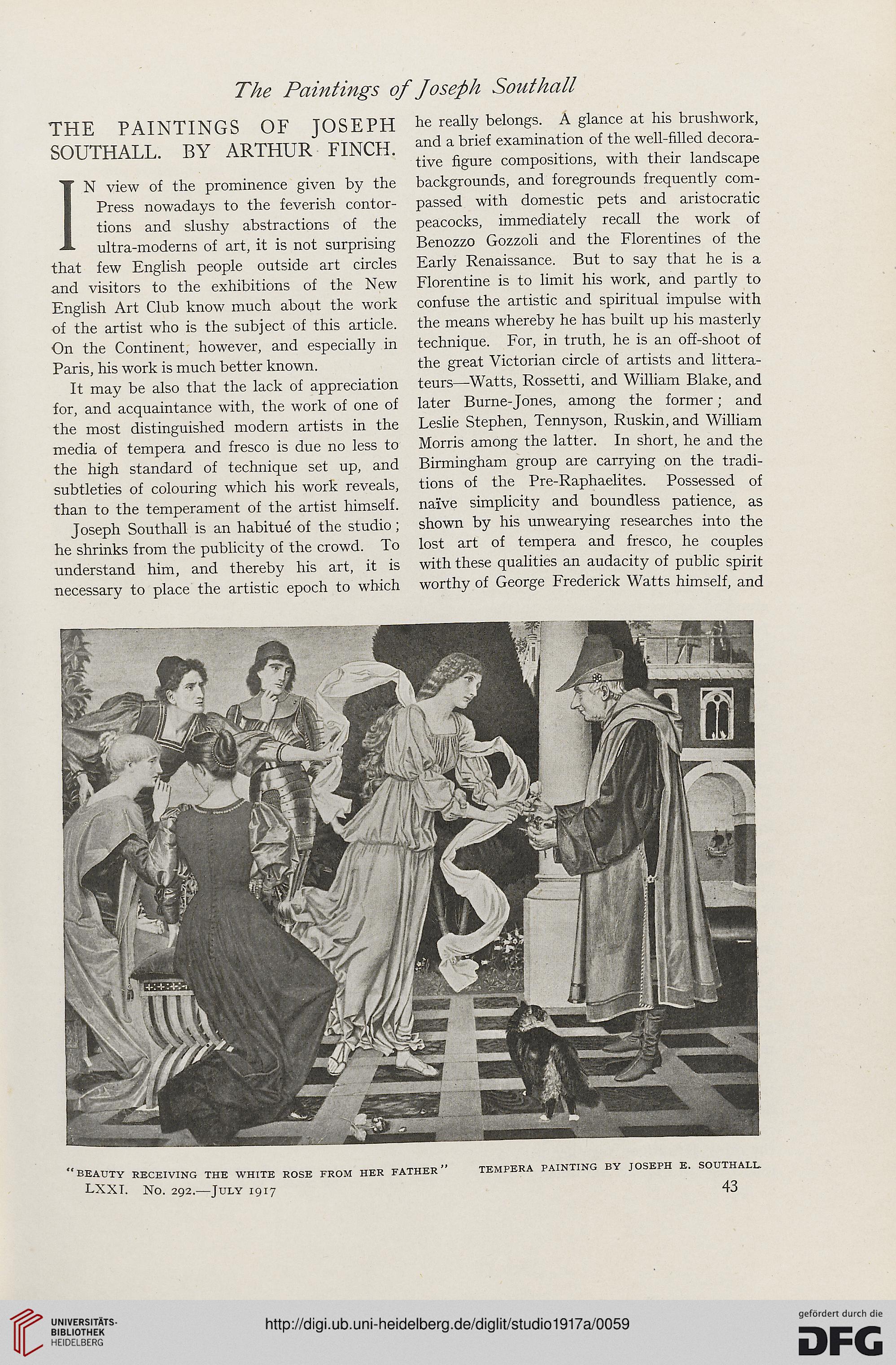The Paintings of Joseph Southall
THE PAINTINGS OF JOSEPH ne really belongs. A glance at his brushwork,
SOUTHALL BY ARTHUR FINCH an(^ a exannnation of the well-filled decora-
tive figure compositions, with their landscape
IN view of the prominence given by the backgrounds, and foregrounds frequently com-
Press nowadays to the feverish contor- passed with domestic pets and aristocratic
tions and slushy abstractions of the peacocks, immediately recall the work of
ultra-moderns of art, it is not surprising Benozzo Gozzoli and the Florentines of the
that few English people outside art circles Early Renaissance. But to say that he is a
and visitors to the exhibitions of the New Florentine is to limit his work, and partly to
English Art Club know much about the work confuse the artistic and spiritual impulse with
of the artist who is the subject of this article, the means whereby he has built up his masterly
On the Continent, however, and especially in technique. For, in truth, he is an off-shoot of
Paris, his work is much better known. the great Victorian circle of artists and littera-
It may be also that the lack of appreciation teurs—Watts, Rossetti, and William Blake, and
for, and acquaintance with, the work of one of later Burne-Jones, among the former ; and
the most distinguished modern artists in the Leslie Stephen, Tennyson, Ruskin, and William
media of tempera and fresco is due no less to Morris among the latter. In short, he and the
the high standard of technique set up, and Birmingham group are carrying on the tradi-
subtleties of colouring which his work reveals, tions of the Pre-Raphaelites. Possessed of
than to the temperament of the artist himself, naive simplicity and boundless patience, as
Joseph Southall is an habitue of the studio; shown by his unwearying researches into the
he shrinks from the publicity of the crowd. To lost art of tempera and fresco, he couples
understand him, and thereby his art, it is with these qualities an audacity of public spirit
necessary to place the artistic epoch to which worthy of George Frederick Watts himself, and
"beauty receiving the white rose from her father'
LXXT. No. 292.—July 1917
tempera painting by joseph e. southall
43
THE PAINTINGS OF JOSEPH ne really belongs. A glance at his brushwork,
SOUTHALL BY ARTHUR FINCH an(^ a exannnation of the well-filled decora-
tive figure compositions, with their landscape
IN view of the prominence given by the backgrounds, and foregrounds frequently com-
Press nowadays to the feverish contor- passed with domestic pets and aristocratic
tions and slushy abstractions of the peacocks, immediately recall the work of
ultra-moderns of art, it is not surprising Benozzo Gozzoli and the Florentines of the
that few English people outside art circles Early Renaissance. But to say that he is a
and visitors to the exhibitions of the New Florentine is to limit his work, and partly to
English Art Club know much about the work confuse the artistic and spiritual impulse with
of the artist who is the subject of this article, the means whereby he has built up his masterly
On the Continent, however, and especially in technique. For, in truth, he is an off-shoot of
Paris, his work is much better known. the great Victorian circle of artists and littera-
It may be also that the lack of appreciation teurs—Watts, Rossetti, and William Blake, and
for, and acquaintance with, the work of one of later Burne-Jones, among the former ; and
the most distinguished modern artists in the Leslie Stephen, Tennyson, Ruskin, and William
media of tempera and fresco is due no less to Morris among the latter. In short, he and the
the high standard of technique set up, and Birmingham group are carrying on the tradi-
subtleties of colouring which his work reveals, tions of the Pre-Raphaelites. Possessed of
than to the temperament of the artist himself, naive simplicity and boundless patience, as
Joseph Southall is an habitue of the studio; shown by his unwearying researches into the
he shrinks from the publicity of the crowd. To lost art of tempera and fresco, he couples
understand him, and thereby his art, it is with these qualities an audacity of public spirit
necessary to place the artistic epoch to which worthy of George Frederick Watts himself, and
"beauty receiving the white rose from her father'
LXXT. No. 292.—July 1917
tempera painting by joseph e. southall
43




